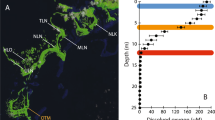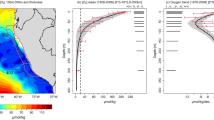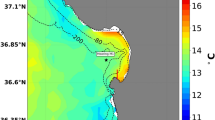Abstract
The decline of dissolved oxygen in the oceans could be detrimental to marine life and biogeochemical cycles. However, predicting future oxygen availability with models that mainly focus on temporal and spatial large-scale mean values could lead to incorrect predictions. Marine ecosystems are strongly influenced by short temporal- and small spatial-scale oxygen fluctuations. Large-scale modelling neglects fluctuations, which include the pervasive occurrence of high oxygen supersaturation on a daily time scale in productive ecosystems such as coral reefs, seagrass meadows and mangrove forests and the spatial heterogeneity in oxygen availability at microclimatic scales. In these temporal and spatial micro-environments, oxygen fluctuations control biogeochemical cycles and alter community responses to, for example, heat stress and hypoxia. Robust projections on the impact of predicted ocean and coastal deoxygenation require a better understanding of the dynamics of the dissolved oxygen coupled with scaled-down projections of oxygen fluctuations at small relevant scales for marine biogeochemical processes and communities. Overall, the study of the true oxygen dynamics in marine productive habitats can provide crucial insights into the feedback mechanisms between climate change and marine ecosystems and can help to develop effective management and conservation strategies.
This is a preview of subscription content, access via your institution
Access options
Access Nature and 54 other Nature Portfolio journals
Get Nature+, our best-value online-access subscription
$29.99 / 30 days
cancel any time
Subscribe to this journal
Receive 12 print issues and online access
$259.00 per year
only $21.58 per issue
Buy this article
- Purchase on Springer Link
- Instant access to full article PDF
Prices may be subject to local taxes which are calculated during checkout


Similar content being viewed by others
Data availability
Data from the Red Sea were retrieved from Giomi et al.10. Data from Venice Lagoon are available from the hydrobiological station Umberto D’Ancona at Chioggia, Italy (https://chioggia.biologia.unipd.it/en/the-database/parameters-of-lagoon/2017/ and https://chioggia.biologia.unipd.it/en/the-database/parameters-of-lagoon/2018/). Data from the Balearic Islands were retrieved from ref. 49. All of the data have been collated and are available as Supplementary Data 1.
References
Schmidtko, S., Stramma, L. & Visbeck, M. Decline in global oceanic oxygen content during the past five decades. Nature 542, 335–339 (2017).
Breitburg, D. et al. Declining oxygen in the global ocean and coastal waters. Science 359, eaam7240 (2018).
Keeling, R. F., Körtzinger, A. & Gruber, N. Ocean deoxygenation in a warming world. Ann. Rev. Mar. Sci. 2, 199–229 (2010).
Laffoley, D. D. A. & Baxter, J. M. Ocean Deoxygenation: Everyone’s Problem. Causes, Impacts, Consequences and Solutions (IUCN, 2019).
Tomasetti, S. J. & Gobler, C. J. Dissolved oxygen and pH criteria leave fisheries at risk. Science 368, 372–373 (2020).
Duarte, C. M. et al. Rebuilding marine life. Nature 580, 39–51 (2020).
Booth, J. et al. Diel oxygen fluctuation drives the thermal response and metabolic performance of coastal marine ectotherms. Proc. R. Soc. B Biol. Sci. 288, 20211141 (2021).
Bernhardt, J. R., O’Connor, M. I., Sunday, J. M. & Gonzalez, A. Life in fluctuating environments. Phil. Trans. R. Soc. Lond. B Biol. Sci. 375, 20190454 (2020).
Blewett, T. A. et al. Physiological and behavioural strategies of aquatic animals living in fluctuating environments. J. Exp. Biol. 225, jeb242503 (2022).
Giomi, F. et al. Oxygen supersaturation protects coastal marine fauna from ocean warming. Sci. Adv. 5, eaax1814 (2019).
Morash, A. J., Neufeld, C., MacCormack, T. J. & Currie, S. The importance of incorporating natural thermal variation when evaluating physiological performance in wild species. J. Exp. Biol. 221, jeb164673 (2018).
Legendre, L. in Ocean in the Earth System (eds Monaco, A. & Prouzet, P.) 145–188 (Wiley, 2014).
Kroeker, K. J. et al. Ecological change in dynamic environments: accounting for temporal environmental variability in studies of ocean change biology. Glob. Change Biol. 26, 54–67 (2020).
Falkowski, P. G. et al. Ocean deoxygenation: past, present, and future. Eos Trans. Am. Geophys. Union 92, 409–410 (2011).
Bates, A. E. et al. Biologists ignore ocean weather at their peril. Nature 560, 299–301 (2018).
Hull, V., Parrella, L. & Falcucci, M. Modelling dissolved oxygen dynamics in coastal lagoons. Ecol. Modell. 211, 468–480 (2008).
Jenkins, W. J. & Goldman, J. C. Seasonal oxygen cycling and primary production in the Sargasso Sea. J. Mar. Res. 43, 465–491 (1985).
Potter, K. A., Arthur Woods, H. & Pincebourde, S. Microclimatic challenges in global change biology. Glob. Change Biol. 19, 2932–2939 (2013).
Stanev, E. V. et al. Understanding the dynamics of the oxic–anoxic interface in the Black Sea. Geophys. Res. Lett. 45, 864–871 (2018).
Shashar, N., Cohen, Y. & Loya, Y. Extreme diel fluctuations of oxygen in diffusive boundary layers surrounding stony corals. Biol. Bull. 185, 455–461 (1993).
Zhan, P., Subramanian, A. C., Yao, F. & Hoteit, I. Eddies in the Red Sea: a statistical and dynamical study. J. Geophys. Res. Oceans 119, 3909–3925 (2014).
Long, M. H., Sutherland, K., Wankel, S. D., Burdige, D. J. & Zimmerman, R. C. Ebullition of oxygen from seagrasses under supersaturated conditions. Limnol. Oceanogr. 65, 314–324 (2020).
Struebig, M. J. et al. Safeguarding imperiled biodiversity and evolutionary processes in the Wallacea Center of Endemism. Bioscience 72, 1118–1130 (2022).
Vaquer-Sunyer, R. & Duarte, C. M. Thresholds of hypoxia for marine biodiversity. Proc. Natl Acad. Sci. USA 105, 15452–15457 (2008).
Craig, H. & Hayward, T. Oxygen supersaturation in the ocean: biological versus physical contributons. Science 735, 1983–1986 (1983).
Alvarenga, D. O., Rigonato, J., Branco, L. H. Z. & Fiore, M. F. Cyanobacteria in mangrove ecosystems. Biodivers. Conserv. 24, 799–817 (2015).
Freeman, S. E., Freeman, L. A., Giorli, G. & Haas, A. F. Photosynthesis by marine algae produces sound, contributing to the daytime soundscape on coral reefs. PLoS ONE 13, e0201766 (2018).
Fusi, M., Daffonchio, D., Booth, J. & Giomi, F. Dissolved oxygen in heterogeneous environments dictates the metabolic rate and thermal sensitivity of a tropical aquatic crab. Front. Mar. Sci. 8, 767471 (2021).
McArley, T. J., Morgenroth, D., Zena, L. A., Ekström, A. T. & Sandblom, E. Prevalence and mechanisms of environmental hyperoxia-induced thermal tolerance in fishes. Proc. R. Soc. B Biol. Sci. 289, 20220840 (2022).
McArley, T. J., Morgenroth, D., Zena, L. A., Ekström, A. T. & Sandblom, E. Experimental hyperoxia (O2 supersaturation) reveals a gill diffusion limitation of maximum aerobic performance in fish. Biol. Lett. 18, 20220401 (2022).
Morris, J. J., Rose, A. L. & Lu, Z. Reactive oxygen species in the world ocean and their impacts on marine ecosystems. Redox Biol. 52, 102285 (2022).
Limatola, N. et al. Oxygen supersaturation mitigates the impact of the regime of contaminated sediment reworking on sea urchin fertilization process. Mar. Environ. Res. 158, 104951 (2020).
Chiarore, A. et al. Sea urchin chronicles. The effect of oxygen super-saturation and marine polluted sediments from Bagnoli-Coroglio Bay on different life stages of the sea urchin Paracentrotus lividus. Mar. Environ. Res. 159, 104967 (2020).
Riser, S. C. & Johnson, K. S. Net production of oxygen in the subtropical ocean. Nature 451, 323–325 (2008).
Kadlec, R. & Wallace, S. D. Treatment Wetlands (Taylor & Francis, 2009).
Madsen, E. L. Microorganisms and their roles in fundamental biogeochemical cycles. Curr. Opin. Biotechnol. 22, 456–464 (2011).
Irby, I. D., Friedrichs, M. A. M., Da, F. & Hinson, K. E. The competing impacts of climate change and nutrient reductions on dissolved oxygen in Chesapeake Bay. Biogeosciences 15, 2649–2668 (2018).
Bui, L. T. & Tran, D. L. T. Assessing marine environmental carrying capacity in semi-enclosed coastal areas—models and related databases. Sci. Total Environ. 838, 156043 (2022).
Oschlies, A., Koeve, W., Landolfi, A. & Kähler, P. Loss of fixed nitrogen causes net oxygen gain in a warmer future ocean. Nat. Commun. 10, 2805 (2019).
Capone, D. G., Bronk, D. A., Mulholland, M. R. & Carpenter, E. J. Nitrogen in the Marine Environment (Elsevier, 2008).
Garcias-Bonet, N. et al. High denitrification and anaerobic ammonium oxidation contributes to net nitrogen loss in a seagrass ecosystem in the central Red Sea. Biogeosciences 15, 7333–7346 (2018).
Frame, C. H. & Casciotti, K. L. Biogeochemical controls and isotopic signatures of nitrous oxide production by a marine ammonia-oxidizing bacterium. Biogeosciences 7, 2695–2709 (2010).
Wasmund, K., Mußmann, M. & Loy, A. The life sulfuric: microbial ecology of sulfur cycling in marine sediments. Environ. Microbiol. Rep. 9, 323–344 (2017).
Benitez-Nelson, C. R., O’Neill, L., Kolowith, L. C., Pellechia, P. & Thunell, R. Phosphonates and particulate organic phosphorus cycling in an anoxic marine basin. Limnol. Oceanogr. 49, 1593–1604 (2004).
Vargas, C. A. et al. Upper environmental pCO2 drives sensitivity to ocean acidification in marine invertebrates. Nat. Clim. Change 12, 200–207 (2022).
Hofmann, G. E. et al. High-frequency dynamics of ocean pH: a multi-ecosystem comparison. PLoS ONE 6, e28983 (2011).
Wallace, R. B. & Gobler, C. J. The role of algal blooms and community respiration in controlling the temporal and spatial dynamics of hypoxia and acidification in eutrophic estuaries. Mar. Pollut. Bull. 172, 112908 (2021).
Quiñones, R. A., Fuentes, M., Montes, R. M., Soto, D. & León-Muñoz, J. Environmental issues in Chilean salmon farming: a review. Rev. Aquac. 11, 375–402 (2019).
Vaquer-Sunyer, R., Duarte, C. M., Jordà, G. & Ruiz-Halpern, S. Temperature dependence of oxygen dynamics and community metabolism in a shallow Mediterranean macroalgal meadow (Caulerpa prolifera). Estuaries Coasts 35, 1182–1192 (2012).
Acknowledgements
This research was funded by King Abdullah University of Science and Technology through baseline funding to C.M.D. and D.D. and by a Competitive Research Grant (CRG-7-3739) to D.D. (The role of the bacterial symbiome at the gill–water (air) interface in the evolution towards terrestrialization (Microlanding); 1 April 2019 to 31 March 2022). We thank V. Saderne, R. Martinez, F. Lazaro, J. de la Cruz Martinez Ayala and P. Carrillo de Albornoz for assistance with the field work and data collection. We thank R. Marasco for critical revision of the manuscript. We are thankful to L. Sbaragli for critical revision of the abstract of the manuscript.
Author information
Authors and Affiliations
Contributions
F.G. and M.F. conceived of the study. F.G., M.F., A.B. and A.S. analysed and interpreted the results. F.G., A.B. and M.F. wrote the first draft of the manuscript. All authors contributed to and approved the final version of the manuscript.
Corresponding authors
Ethics declarations
Competing interests
The authors declare no competing interests.
Peer review
Peer review information
Nature Geoscience thanks Gil Jacinto, Lillian McCormick and the other, anonymous, reviewer(s) for their contribution to the peer review of this work. Primary Handling Editor(s): Rebecca Neely and James Super, in collaboration with the Nature Geoscience team.
Additional information
Publisher’s note Springer Nature remains neutral with regard to jurisdictional claims in published maps and institutional affiliations.
Supplementary information
Supplementary Data 1
Dissolved oxygen and temperature data plotted in Figure 2. Published sources of data are indicated in Column E.
Rights and permissions
Springer Nature or its licensor (e.g. a society or other partner) holds exclusive rights to this article under a publishing agreement with the author(s) or other rightsholder(s); author self-archiving of the accepted manuscript version of this article is solely governed by the terms of such publishing agreement and applicable law.
About this article
Cite this article
Giomi, F., Barausse, A., Steckbauer, A. et al. Oxygen dynamics in marine productive ecosystems at ecologically relevant scales. Nat. Geosci. 16, 560–566 (2023). https://doi.org/10.1038/s41561-023-01217-z
Received:
Accepted:
Published:
Issue Date:
DOI: https://doi.org/10.1038/s41561-023-01217-z
This article is cited by
-
The deepwater oxygen deficit in stratified shallow seas is mediated by diapycnal mixing
Nature Communications (2024)



